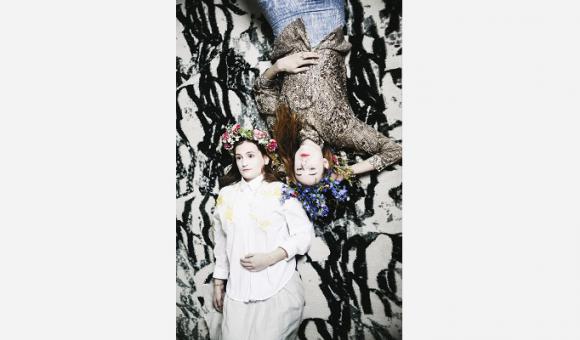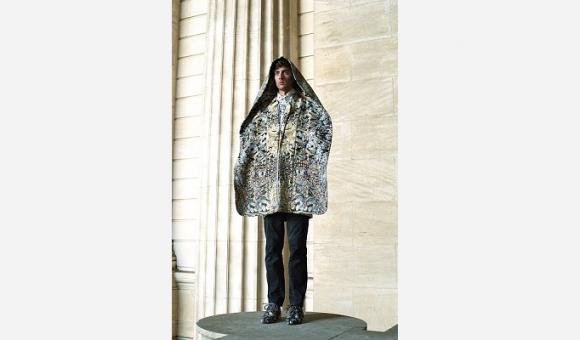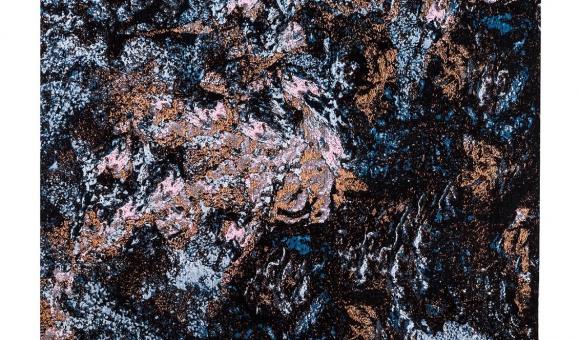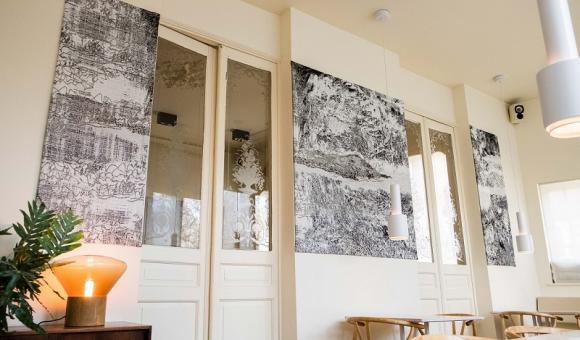
Krjst Studio's Justine de Moriamé and Erika Schillebeeckx do not just create fashion, they seek gold and anticipate trends: mixed, cross-season, eclectic, oversize... You name it. They tell us all about their approach to textile design.
You had just graduated from the La Cambre arts school when you launched your brand, creating two collections a year and participating in all the Fashion Weeks. However, you soon decided to change course.
Since the launch of Krjst in 2012, we have opted for an approach that puts visual arts centre stage. However, we very quickly realised we wanted to dig deeper, mix genres and go beyond classic ready-to-wear, and that was not compatible with the hectic pace dictated by the sector. After two years, we therefore chose to shift the focus of our studio, putting clothing design on hold. Today, we create images, scenographies, textiles and much more. And looking back, it has been a positive experience. It has allowed us to clearly define our priorities, values and interests in textile design, while steering away from what does not interest us.
You could have quit, but you chose to walk a different path...
That's right. We were lucky enough - thanks to social media - to attract brands like Eastpak, Disney, Rochas, Mc Alson and Huawei. Our meetings with the representatives of these brands resulted in the development of consumer goods (prints for backpacks and boxer shorts, background images for mobiles and so on) that put our studio on the map and gave us the push we needed to thrive. At the same time, we've continued our search for the perfect graphics by exploring other aspects of textile creation.
One of these aspects is weaving, a technique that has produced several artworks displayed both at art galleries and in public spaces.
Our woven pieces perfectly reflect our universe and values. Krjst is a research lab, a mix of emotions compressed into one, with interwoven snippets of stories. We've also been lucky enough that galleries and private clients picked up on our work. Bouchery, a restaurant in Brussels, for example, ordered an exclusive triptych. We have also worked with N. Vrouyr, a producer of hand-made carpets based in Antwerp, creating two exclusive patterns. And now we are about to launch a project with a jewellery designer in Brussels and we are heading to the Beirut Art Fair, Fiac and YIA Art Fair in Paris.
Your joint work is somewhat atypical. What's your approach?
Our graphical and technical explorations are quite unique, that's right. We create each and every one of our experiments - both by hand and digitally - and then we join them into a final work using a large loom.
So clothing is a thing of the past now?
Not at all! We've simply come up with a different approach to clothing. In the run-up to the launch of our project Inri, we had already included a selection of 'mixed clothing’ on our website, inspired by the collections we had developed from 2012 to 2014 - from woven coats and bomber jackets to silk shirts, shawls and much more. These pieces were only available upon order, in limited and numbered editions. We propose clothing as timeless collections that our customers develop themselves, rather than pieces linked to specific seasons.
Is that what the Inri capsule collection is all about?
Yes, it’s a continuation of this approach. The name of this collection is based on the Latin INRI, ‘Igne Natura Renovatur Integra’, which translates as 'through fire, nature is reborn whole'. It perfectly captures all of our values: art, craftsmanship and sustainability. We will be launching new fabrics and prints once a year. Every piece of clothing will be sold online, during presentations at art galleries and in pop-up stores, for example at the Daniel Crouch gallery in London as part of the Frieze Art Fair. They will be numbered and signed, and there will be no more than seven pieces of each model.
So one and the same piece will capture your entire universe...
Yes, including the idea of sustainability through our choice of materials. So one and the same woven coat could include rubber, mohair, raffia and cotton, all woven using large looms connected to computers. This technique allows us to create super sophisticated patterns, bridging the gap between craftsmanship and technology. As for the prints on our silk shirts, they depict objects we left to oxidise. We then scanned them to create odd patterns with a copper glow. Our approach is dictated by such experiments. We are so passionate about it that we hope to one day open the doors to our universe and show the world what goes on behind the scenes.
You have spoken a lot about how you explore materials. Where does shape come in?
We've stayed true to the identity we shaped after graduating from La Cambre, from Japanese influences to rounded armholes, exaggerated volumes bordering on oversized and unisex designs. That being said, we've perfected our favourite models with the idea of pushing our exploration of materials and shapes even further.
By Marie Honnay
For the latest news about designers in Wallonia-Brussels have a look at the WBDM website.


